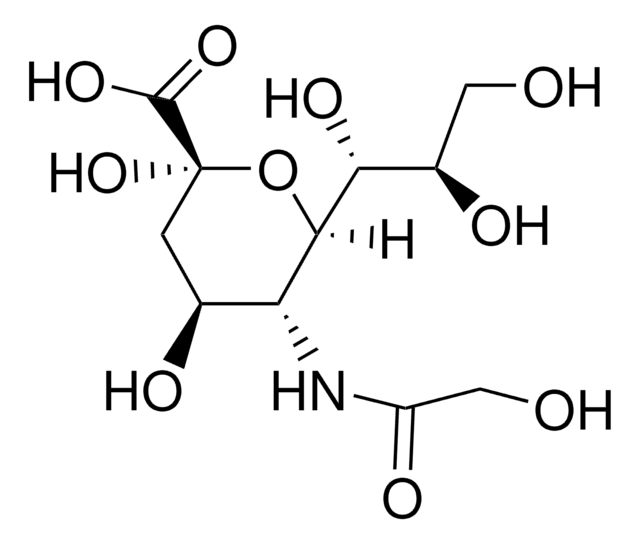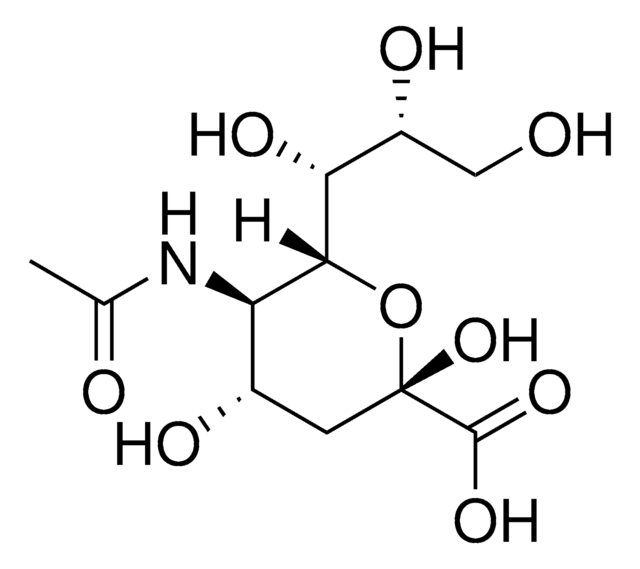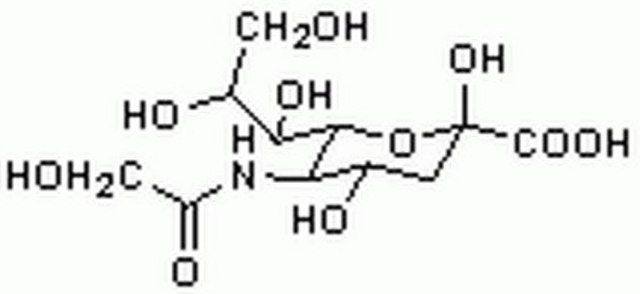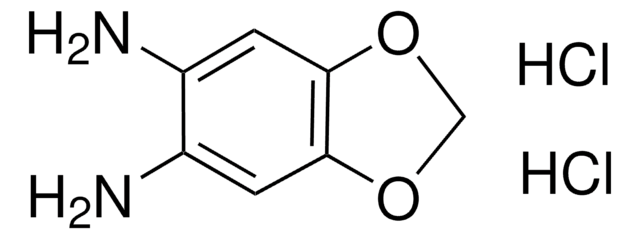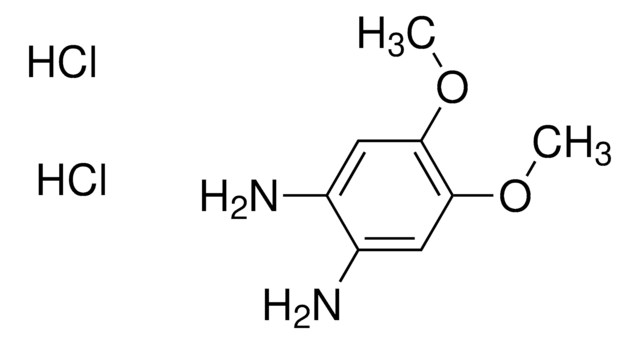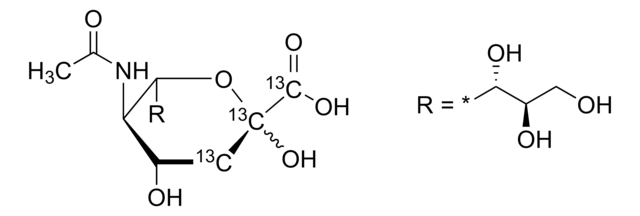50644
N-Glycolylneuraminic acid
≥95% (HPLC)
Synonym(s):
Neu5Glc, NeuNGl
Sign Into View Organizational & Contract Pricing
All Photos(1)
About This Item
Empirical Formula (Hill Notation):
C11H19NO10
CAS Number:
Molecular Weight:
325.27
Beilstein:
1716828
MDL number:
UNSPSC Code:
12352201
PubChem Substance ID:
Recommended Products
biological source
synthetic
Quality Level
Assay
≥95% (HPLC)
form
powder
storage temp.
−20°C
SMILES string
[H][C@]1(O[C@@](O)(C[C@H](O)[C@H]1NC(=O)CO)C(O)=O)[C@H](O)[C@H](O)CO
InChI
1S/C11H19NO10/c13-2-5(16)8(18)9-7(12-6(17)3-14)4(15)1-11(21,22-9)10(19)20/h4-5,7-9,13-16,18,21H,1-3H2,(H,12,17)(H,19,20)/t4-,5+,7+,8+,9+,11-/m0/s1
InChI key
FDJKUWYYUZCUJX-AJKRCSPLSA-N
Looking for similar products? Visit Product Comparison Guide
Application
Glycolylneuraminic acid, a component of non-human milk and colostrums, is used as a reference to analyse changes of the glycome during lactation. Glycolylneuraminic acid, a xenoantigen, is involved in antigenic reactions (antibody-mediated hyperacute rejection) during xenotransplantion.
Other Notes
To gain a comprehensive understanding of our extensive range of Monosaccharides for your research, we encourage you to visit our Carbohydrates Category page.
Regulation of N-glycolylneuraminic acid biosynthesis in rat and mouse liver
Sales restrictions may apply
Storage Class Code
11 - Combustible Solids
WGK
WGK 3
Flash Point(F)
Not applicable
Flash Point(C)
Not applicable
Personal Protective Equipment
dust mask type N95 (US), Eyeshields, Gloves
Choose from one of the most recent versions:
Already Own This Product?
Find documentation for the products that you have recently purchased in the Document Library.
A Lepers et al.
European journal of biochemistry, 193(3), 715-723 (1990-11-13)
The relative contribution of N-glycoloyl-beta-D-neuraminic acid (Neu5Gc) to total sialic acids expressed in mouse and rat liver glycoconjugates was found to be 95% and 11%, respectively. This considerable difference in sialic acid composition made these two tissues suitable models for
D C Hurum et al.
Journal of dairy science, 95(3), 1152-1161 (2012-03-01)
Sialic acid determination in an infant formula presents many challenges, including efficient sialic acid release from glycoconjugates, effective sample preparation, and rugged chromatography. This work compares 2 chromatographic assays developed for determination of sialic acids in infant formula. Prior to
On the differential sialic acid specificity of lectins from different parts of Saraca indica.
Bishnu P Chatterjee et al.
Advances in experimental medicine and biology, 705, 213-228 (2011-05-28)
Nabin B Basnet et al.
Xenotransplantation, 17(6), 440-448 (2010-12-17)
A number of carbohydrate structures apart from Galα1-3Galβ1-4GlcNAc (Gal) have been implicated as potential xenoantigens. Epitopes of another carbohydrate structure, namely N-glycolylneuraminic acid (NeuGc), are widely expressed on the surfaces of endothelial cells of all mammals, except humans, and are
Eiki Maeda et al.
Analytical chemistry, 84(5), 2373-2379 (2012-03-08)
Minor N-linked glycans containing N-glycolylneuraminic acid residues and/or α-Gal epitopes (i.e., galactose-α1,3-galactose residues) have been reported to be present in recombinant monoclonal antibody (mAb) therapeutics. These contaminations are due to their production processes using nonhuman mammalian cell lines in culture
Our team of scientists has experience in all areas of research including Life Science, Material Science, Chemical Synthesis, Chromatography, Analytical and many others.
Contact Technical Service